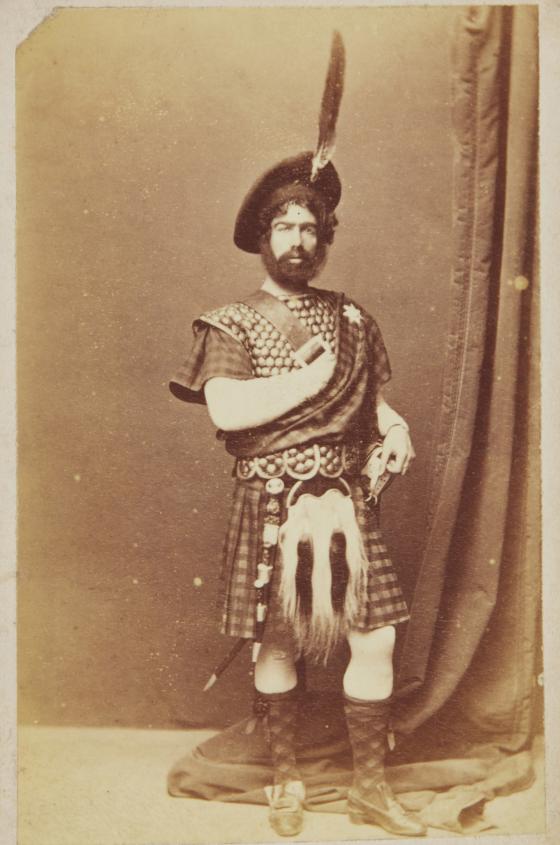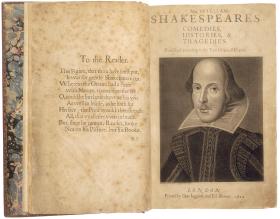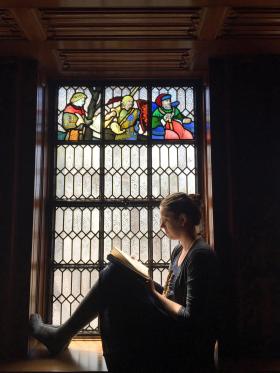In September 1867, the grandly named Royal Lyceum Theatre opened on Calcutta’s maidan, a vast expanse of greenery that lay between the so-called White Town and the Hooghly River. Made from bamboo and corrugated iron and able to seat 800 spectators, the theatre was erected by GBW Lewis, an impresario. The Bengal Hurkaru newspaper applauded the theatre’s ‘ample and imposing stage’, gilt plaster ornamentation and red velvet seats. Presenting a mix of Shakespearean dramas and the latest theatrical productions from Drury Lane, Lewis’s company played to full houses — until disaster struck. A month after it opened, the structure was flattened by a cyclone.
The London-born Lewis was among the earliest theatrical entrepreneurs to tap into Asia’s insatiable appetite for entertainment. After arriving in Australia in 1853, he started an equestrian circus that performed across the goldfields in NSW and Victoria. In 1859, he decided to tour his troupe of five adults and four children to Hong Kong and China, lured by the prospect of larger audiences — and greater profits. A year later his Great Australian Hippodrome and Mammoth Amphitheatre arrived in Calcutta. Its cast of players included ‘Lilliputian Tom’; JM Wolfe, ‘the celebrated Shakespearean Jester’; the brothers Leopold and Austin Shangahae and a ‘host of other celebrities’.
Actor–managers such as Lewis trawled the entertainment circuits that spanned the Indian and Pacific Oceans. Many sprang up in the 1850s alongside the gold rushes in California and the Australian colonies, presenting everything from circus to Shakespeare, minstrelsy to magic, vaudeville to ventriloquism. Theatres, tents, town halls, army barracks, mess rooms and clubhouses became focal points for a whole gamut of performances that catered to both expatriates and locals.
Australia, located at the intersection of these two circuits, was strategically placed to export its talent to the world. As another impresario, Robert ‘Sparrow’ Smythe, remarked in 1871, it was from Australia, not Europe, ‘that the East receives its supplies of musical, dramatic, and other travelling troupes’.
Smythe, who like Lewis was born in England and had made Australia his home, was struck by the adventurous spirit of these ‘wanderers’. ‘Wherever I have been east of the Cape of Good Hope, I have met some kind of professionals either sojourning, or enroute, voyaging at sea in large ships or small, or travelling on land by railroad and dak gharree, on horseback, in sampans, dandy dhoolie, palankeen, and sedan-chair; in buggy, tent-cart, stage-coach, and omnibus; by bullock-train and mule-waggon, and even on the back of commissariat elephants.’
Lewis would have sampled most of these modes of transport during his travels in India and China. He epitomised the spirit of Smythe’s professionals, but such tours took a heavy toll. After their initial Calcutta seasons, Lewis went with his heavily pregnant young wife Rose Edouin and the rest of the company on a gruelling tour through northern India. In April 1868, their 10-monthold daughter Lucy May died of convulsions. While recuperating from their travels in the Himalayan hill station of Simla, the couple’s third child William was born but sadly died a year later from bronchitis. Shortly afterwards, Rose’s brother Charles succumbed to heat exhaustion.
In 1871, Lewis opened his first brick and mortar venue, the Theatre Royal on Calcutta’s main thoroughfare Chowringhee. The Lewis Dramatic and Burlesque Company premiered with a performance of Leicester Buckingham’s play The Silver Lining followed by a season of Othello in which Rose played Emilia. A month later Lewis staged ‘a Grand Production of Macbeth’ with the multitalented Rose as Lady Macbeth and a choir of 100 voices.
India’s appetite for Shakespeare dates back to the early eighteenth century with the publication of local English-language editions of the Bard’s works. Popular Shakespearean dramas became the mainstay for amateur theatre groups from the 1770s onwards, initially for the benefit of English residents in Bombay and Calcutta.
In 1831, a company of Bengali actors staged Julius Caesar in their own Hindu Theatre and in 1848 a Bengali actor, Bhaishnav Charan Adhya, played Othello in a production with an otherwise all-English cast. With the passing of the 1835 India Education Bill, which made English the language of instruction in government-funded schools and colleges, Shakespeare became a part of the ‘civilising’ mission of the Raj, designed to produce ‘a class of persons Indian in blood and colour, but English in taste, in opinion, in morals and in intellect’.
Students flocked to theatres to improve their elocution. As one commentator noted in The Times of India in 1868, ‘Shakespeare has been studied by our Baboos in their educational course at universities or college and they regard anything below Shakespeare as something scarcely worth notice.’
Indian playwrights soon began adapting the Bard’s works, translating plays into local languages, rearranging plots, changing names and adding song and dance routines. Audiences were naturally drawn to the figure of Hamlet, who shares remarkable similarities with Arjuna, the mythical king of the Pandavas in the Sanskrit epic the Mahabharata. Both are princes who find themselves trapped in a world of war, intrigue and deceit. Both must grapple with the fact that the only resolution to their plight is the shedding of family blood.
GBW Lewis and Rose Edouin’s association with Calcutta left a lasting legacy. A frequent visitor at Theatre Royal was Girish Chandra Ghosh, who is now regarded as the founder of the modern Indian stage. Ghosh developed his acting talents by watching their plays and even copied the theatre’s layout when designing his own venue. Edouin became Ghosh’s mentor and the pair discussed European dramas and performances.
Another Australian actor–manager who exported Shakespeare to Asia was Hobart-born Harry P Lyons. After briefly performing in an equestrian circus with Rose’s brother Willie Eduoin in the 1850s, Lyons decided that his real talents lay in theatre management. Over a career that spanned six decades, he managed dozens of companies and performers, including the Australian tour of Blondin, the first man to cross the Niagara Falls on a high wire. Other companies Lyons managed on their tours through Asia included Louise Pomeroy’s Shakespearean Dramatic Company and George C Miln’s Shakepearean Revivals.
Fresh from a successful season in Australia, Miln spent two years in India from 1890 presenting an all-Shakespearean repetoire, organising readings of the playwright’s work and rehearsing with local companies. Calcutta newspaper The Englishman praised him as ‘the first manager who has attempted an adequate staging of these great plays in India’. In 1892 Miln played Shylock in a production of The Merchant of Venice by the Bombay Amateur Dramatic Company, whose members came from the city’s Parsi community.
Lyons himself spent enough time presenting had to be when playing before an audience of Bengalis. He told one interviewer: ‘The Baboo takes his copy of Shakespeare with him to the play and does not mind correcting you and arguing the point if he thinks you are wrong.’
Sharp-eyed critics were not the only hazards Shakespearean actors faced in India. The Bard’s plays often called for heavy costumes that were unsuited to the tropics. Canadian-born Matheson Lang, the lead actor with the Holloway Touring Theatre Company, complained that his makeup was constantly running down his face. Perspiration caused actors’ beards to fall off. When the company landed in Calcutta in 1912, they found the publicity posters for their forthcoming season had been printed with the wrong dates. On arriving in Bombay, they discovered that 200 tonnes of scenery was stuck at Nagpur in central India, forcing the cancellation of the opening night’s performance. But the show did go on.
The Holloway Touring Theatre Company was among the most successful Australian ensembles to take Shakespeare to Asia. The company was founded by William John Holloway, a former boilermaker turned actor–manager, who began his career with the Redfern Amateur Dramatic Club in Sydney. Holloway’s wife, Emily Jennings’s daughter, Essie Jenyns, was considered the finest Shakespearean actress of her day in Australia.
Holloway also toured South Africa between 1895 and 1905 and, in 1911, undertook a two-year Asian circuit, playing to audiences from Bombay to Shanghai. The pace was hectic. During a nineday season in January 1912 at Singapore’s Victoria Theatre, the company staged six plays: The Taming of the Shrew, Hamlet, The Merchant of Venice, Romeo and Juliet, Much Ado About Nothing and Othello.
Perspiration caused actors’ beards to fall off.
While performing in Calcutta in 1911, Lang and Holloway found themselves competing with Allan Wilkie’s Shakespearean company, which was beginning a three-year Asian tour to Ceylon, Singapore, British Malaya, Hong Kong, China, Japan and the Philippines. Whereas Holloway’s company played to predominantly European audiences, Wilkie drew crowds of Bengalis when he performed at the Kohinoor Theatre on Beadon Street in the heart of Calcutta’s so-called ‘native’ quarter. ‘During the more pathetic and moving scenes of Othello they would weep openly and unashamed,’ Wilkie wrote in his memoir All the World My Stage. ‘The realistic combat between Macbeth and Macduff aroused them to such a frenzy of excitement and panic that many of them dived under their seats and others made a mad rush for the doors.’
Wilkie’s memoir also captures the sometimescomical side of touring in Asia. At the Grand Opera House in Calcutta, his actors struggled to be heard above the noise of monkeys in the theatre’s roof, who threw pieces of wood and spanners onto the stage below. Bouts of sickness often left productions short of actors. In one performance of Romeo and Juliet, Wilkie played the roles of Friar Lawrence, Mercutio and Prince Escalus.
Despite these hardships Wilkie never lost sight of the rewards of presenting Shakespeare in the distant corners of the empire. When news spread that his company was presenting Hamlet in Bangalore, half a dozen students from a remote village walked for 60 miles through the jungle before taking a 300-mile train ride for a once-in-a-lifetime opportunity to see the play. The return journey took more than a week and, as Wilkie noted, probably consumed a year’s savings for each of them. ‘One cannot but lament that such extreme devotion to our national poet is rarely, if ever, to be found amongst his fellow countrymen,’ he wrote.
In 1916, Wilkie settled in Australia and four years later established Australia’s first permanent touring Shakespeare company in 1920. His ambition was to present all 37 of the Bard’s plays in towns and cities around the country. He managed only 27 before the Great Depression made touring unviable.
Shakespeare’s presence in Asia has been described as part of the ‘baggage of empire’, but as the experience of Lewis, Edouin, Smythe, Lyons, Holloway and others testifies, his works had universal appeal. Wilkie reminisced: ‘I had transported my company some 30,000 miles or more by land and sea and produced over 30 plays, staging Shakespeare in many places for the first time and frequently to alien races whose enthusiastic appreciation testified once more that not only is Shakespeare for all time but for all peoples.’
John Zubrzycki was the 2021 Merewether Fellow at the State Library of NSW, researching Australian popular culture in Asia in the late nineteenth and early twentieth centuries.
This story appears in Openbook winter 2023.







